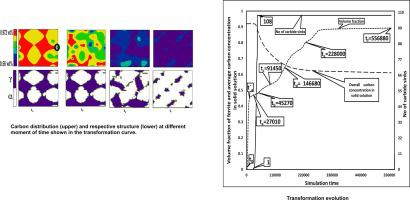当前位置:
X-MOL 学术
›
Comp. Mater. Sci.
›
论文详情
Our official English website, www.x-mol.net, welcomes your
feedback! (Note: you will need to create a separate account there.)
Interaction between carbon partitioning and carbide nucleation inside austenite during a bainitic type transformation
Computational Materials Science ( IF 3.1 ) Pub Date : 2020-11-01 , DOI: 10.1016/j.commatsci.2020.109846 F. Elhigazi , A. Artemev
Computational Materials Science ( IF 3.1 ) Pub Date : 2020-11-01 , DOI: 10.1016/j.commatsci.2020.109846 F. Elhigazi , A. Artemev

|
Abstract The interaction between the displacive transformation, carbon partitioning and carbide nucleation inside austenite during a bainitic type transformation was studied using a phase field model incorporating the displacive transformation and diffusion processes. The carbide nucleation was modeled as a formation of carbon sinks inside austenite with different nucleation sequences. The results obtained with different nucleation sequences demonstrate that carbide nucleation may play a secondary role controlling the transformation kinetics and microstructure evolution after the fast transformation stage completion; however, elastic interactions can control the ferrite morphology even at a later stage, thus leading to the change of the ferrite grain shape from a rod-like to plate-like. A rate of the carbide nucleation and the number of nucleated carbides controlled the extension of the stasis period separating the fast and slow transformation stages and the rate of the transformation after the stasis or during a temporary slowdown period. Results show that the transformation can proceed through several slowdown - acceleration periods.
中文翻译:

贝氏体相变过程中碳分配与奥氏体内部碳化物形核的相互作用
摘要 使用结合位移相变和扩散过程的相场模型研究了贝氏体型相变过程中奥氏体内部位移相变、碳分配和碳化物形核之间的相互作用。碳化物成核被模拟为具有不同成核序列的奥氏体内部碳汇的形成。不同形核序列的结果表明,在快速相变阶段完成后,碳化物形核可能起次要作用,控制相变动力学和微观结构演变;然而,即使在后期,弹性相互作用也可以控制铁素体形貌,从而导致铁素体晶粒形状从棒状变为板状。碳化物成核的速率和成核的碳化物的数量控制了将快速和慢速相变阶段分开的停滞期的延长以及停滞后或暂时减速期期间的相变速率。结果表明,转换可以通过几个减速-加速期进行。
更新日期:2020-11-01
中文翻译:

贝氏体相变过程中碳分配与奥氏体内部碳化物形核的相互作用
摘要 使用结合位移相变和扩散过程的相场模型研究了贝氏体型相变过程中奥氏体内部位移相变、碳分配和碳化物形核之间的相互作用。碳化物成核被模拟为具有不同成核序列的奥氏体内部碳汇的形成。不同形核序列的结果表明,在快速相变阶段完成后,碳化物形核可能起次要作用,控制相变动力学和微观结构演变;然而,即使在后期,弹性相互作用也可以控制铁素体形貌,从而导致铁素体晶粒形状从棒状变为板状。碳化物成核的速率和成核的碳化物的数量控制了将快速和慢速相变阶段分开的停滞期的延长以及停滞后或暂时减速期期间的相变速率。结果表明,转换可以通过几个减速-加速期进行。











































 京公网安备 11010802027423号
京公网安备 11010802027423号